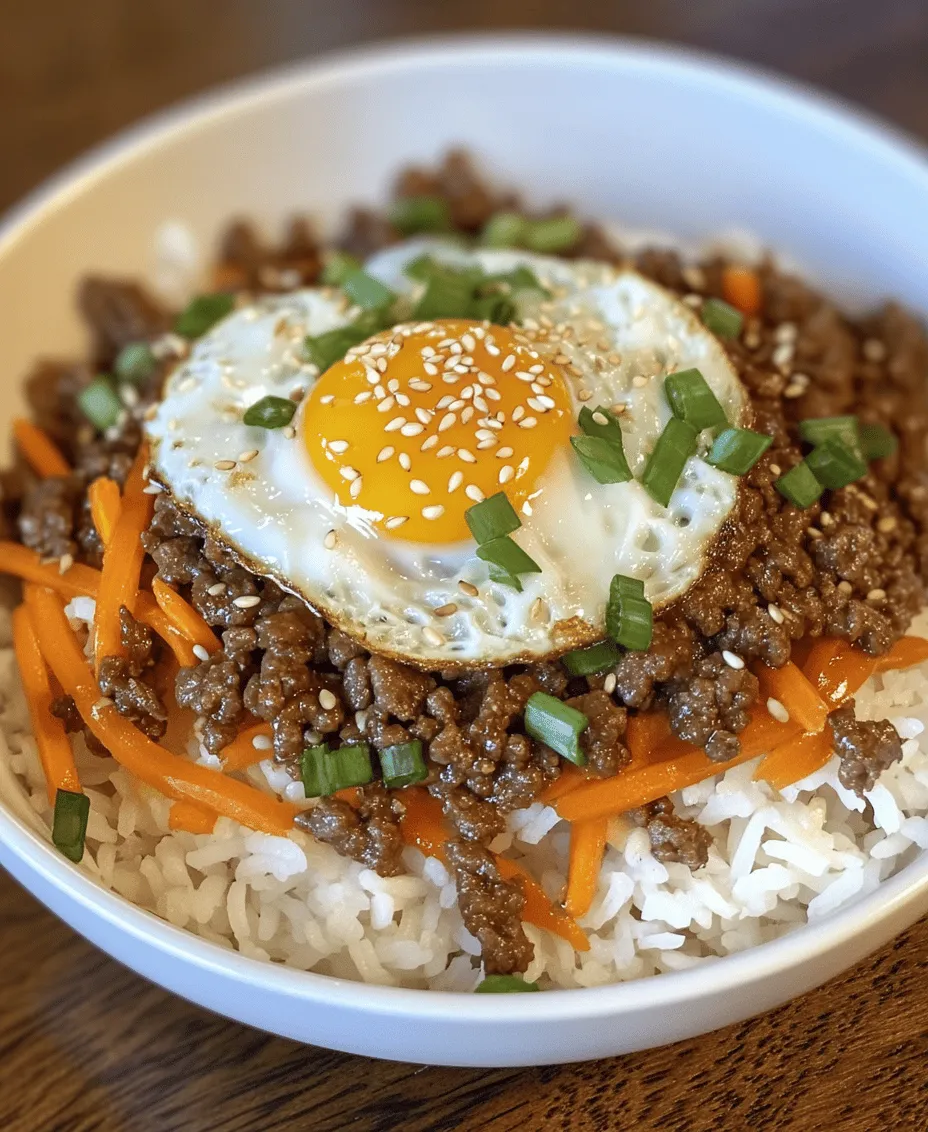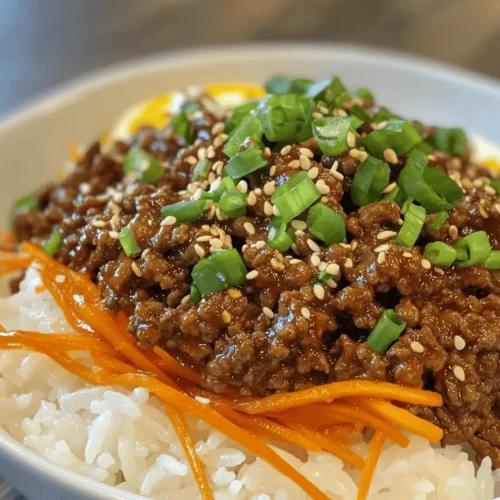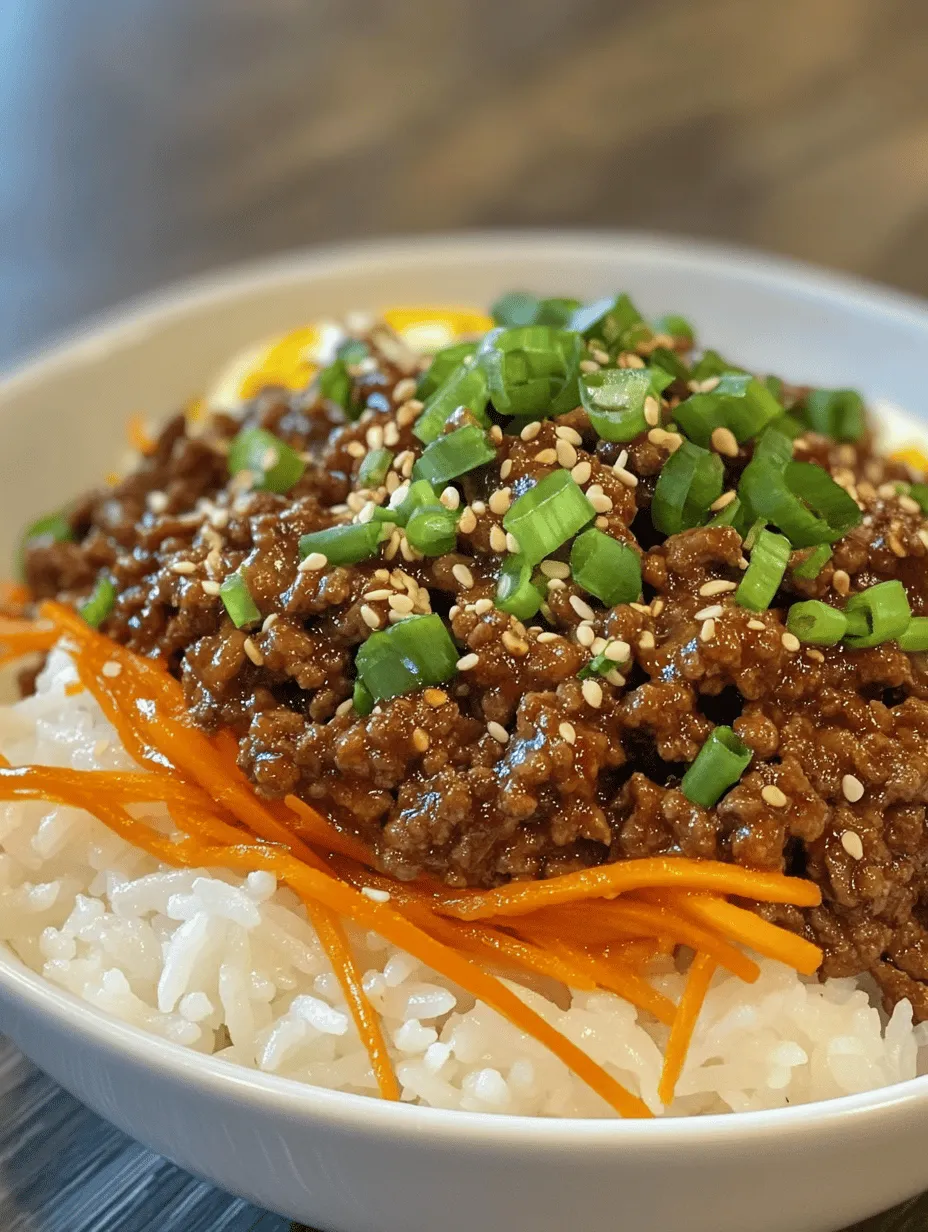Introduction
Korean cuisine has taken the culinary world by storm, captivating taste buds with its unique blend of flavors, textures, and colors. From the iconic kimchi to savory bulgogi, it encompasses a diverse range of dishes that showcase the rich culinary heritage of Korea. One dish that stands out for its simplicity, flavor, and appeal to a wide audience is the Korean Ground Beef Bowl. This quick and satisfying meal option is perfect for anyone looking to enjoy a taste of Korea without spending hours in the kitchen.
The Korean Ground Beef Bowl is a delightful combination of seasoned ground beef, vibrant vegetables, and a mouthwatering sauce that marries sweet, savory, and spicy elements. This dish perfectly balances protein, carbohydrates, and essential nutrients, making it a wholesome meal choice for busy weeknights or meal prep sessions. With its quick preparation time, you can whip up a delicious dinner in under 30 minutes, making it an ideal option for those hectic evenings when time is of the essence.
What makes this dish particularly appealing is its versatility. You can easily customize it to suit your taste preferences by adjusting the level of spice, adding more vegetables, or incorporating different toppings. Whether you’re a seasoned cook or a kitchen novice, this Korean Ground Beef Bowl is sure to become a staple in your recipe repertoire.
Understanding the Ingredients
Before diving into the preparation of the Korean Ground Beef Bowl, it’s essential to understand the key ingredients that contribute to its delightful flavor profile. The quality of the ingredients plays a pivotal role in achieving the dish’s signature taste, so let’s take a closer look at what you’ll need.
Essential Ingredients
1. Ground Beef: The star of this dish is, of course, the ground beef. Using an 80/20 blend of ground beef (80% lean meat and 20% fat) is recommended for optimal flavor and juiciness. The fat content helps to keep the meat tender and adds richness to the overall dish.
2. Aromatics: Garlic and ginger are integral to enhancing the dish’s flavor. Fresh garlic provides a pungent kick that complements the meat, while ginger adds a warm, fragrant note that brightens the overall taste.
3. Sauce Ingredients:
– Soy Sauce: This salty, umami-rich ingredient forms the base of the sauce and infuses the meat with savory depth.
– Brown Sugar: A touch of brown sugar balances the saltiness of the soy sauce and adds a subtle sweetness to the dish.
– Sesame Oil: This fragrant oil contributes a nutty flavor that is characteristic of Korean cuisine.
– Gochujang: This Korean chili paste adds a spicy kick and a depth of flavor that elevates the dish to new heights. Adjust the amount based on your preferred spice level.
– Rice Vinegar: A splash of rice vinegar brightens the flavors and adds a refreshing acidity to the dish.
4. Vegetables: Fresh vegetables not only enhance the flavor but also provide essential nutrients. Common additions include:
– Carrots: These add a natural sweetness and a pop of color. They can be shredded or diced for added texture.
– Green Onions: Also known as scallions, these provide a mild onion flavor and a vibrant green garnish.
5. Optional Toppings: The beauty of the Korean Ground Beef Bowl lies in its versatility. Optional toppings such as sesame seeds, sliced cucumbers, or a fried egg can elevate the dish further, adding extra texture and flavor. These toppings not only enhance the aesthetic appeal but also contribute additional crunch or richness, depending on your choice.
Nutritional Benefits
The Korean Ground Beef Bowl is not just a flavor-packed dish; it also offers numerous nutritional benefits. Ground beef is an excellent source of protein, essential for muscle repair and growth. The inclusion of vegetables like carrots and green onions adds vitamins, minerals, and fiber to the meal, promoting overall health. Additionally, the use of flavorful ingredients like garlic and ginger may offer various health benefits, including anti-inflammatory properties.
Step-by-Step Preparation
Now that you have a good understanding of the ingredients, let’s move on to the preparation steps. This section will guide you through the process of creating a delicious Korean Ground Beef Bowl that is bursting with flavor.
Step 1: Prepare the Ingredients
Before cooking, it’s essential to get organized. Begin by gathering all your ingredients and preparing them for cooking. This includes:
– Finely chopping or mincing the garlic and ginger.
– Dicing the carrots into small, uniform pieces or shredding them for quicker cooking.
– Slicing the green onions, separating the white parts from the green tops, as they will be added at different stages.
Step 2: Cook the Ground Beef
In a large skillet or wok, heat a drizzle of oil over medium-high heat. Once the oil is shimmering, add the ground beef, breaking it apart with a spatula. Allow it to brown without stirring for the first few minutes, which helps develop a nice crust and enhances flavor.
As the beef cooks, season it lightly with salt and pepper. This is the perfect time to add the minced garlic and ginger. Sauté these aromatics with the beef for a minute or two, ensuring they are fragrant but not burned. The goal is to infuse the meat with the savory essence of the garlic and ginger, which will create a rich flavor base for the dish.
Step 3: Combine the Sauce Ingredients
While the beef is cooking, you can prepare the sauce. In a small mixing bowl, combine the soy sauce, brown sugar, sesame oil, gochujang, and rice vinegar. Whisk them together until the sugar is fully dissolved. This sauce will be the magic ingredient that brings the dish together, providing sweetness, heat, and umami.
Step 4: Add the Sauce and Vegetables
Once the ground beef is browned and cooked through, it’s time to add the sauce. Pour the sauce mixture over the beef, stirring to coat evenly. The beef should absorb the sauce, turning a rich brown color.
Next, add the diced carrots and the white parts of the green onions to the skillet. Sauté everything together for an additional 2-3 minutes until the vegetables are tender but still crisp. This step not only incorporates the vegetables into the dish but also allows them to soak up some of the sauce’s flavors.
Step 5: Finish Cooking
As the dish nears completion, taste and adjust the seasoning as needed. If you prefer more heat, you can add additional gochujang or a touch of chili flakes. Once satisfied with the flavor, remove the skillet from the heat.
It’s important to ensure that the beef and vegetables are well-cooked without becoming overdone. The timing and temperature are crucial to maintaining the integrity of the vegetables while ensuring the beef is juicy and flavorful.
Step 6: Serve and Enjoy
Now that your Korean Ground Beef Bowl is ready, it’s time to serve. You can present it over a bed of cooked rice, quinoa, or even cauliflower rice for a healthier twist. Top it with the green parts of the sliced green onions and any other optional toppings you desire, such as sesame seeds or a fried egg, to add extra flavor and texture.
This Korean Ground Beef Bowl is not only a feast for the eyes but also a delicious and satisfying meal that brings the warmth of Korean cuisine to your dining table. Enjoy this dish with family or friends, or pack it for a flavorful lunch that will keep you energized throughout the day.
Stay tuned for the next part of this article, where we will dive deeper into tips for perfecting your Korean Ground Beef Bowl and answer some common questions to ensure your cooking experience is a success!

Tips for Ensuring the Carrots Retain Some Crunch While Still Softening
When preparing your Korean Ground Beef Bowl, achieving the right texture for the carrots is essential. You want them to be tender enough to blend with the savory flavors of the dish, yet still retain a satisfying crunch. Here are some tips to ensure this balance:
1. Cut Uniformly: Slice the carrots into thin matchsticks or julienne them. This not only helps them cook evenly but also ensures that they soften without becoming mushy.
2. Cooking Time: Add the carrots to the pan shortly after the beef has begun to brown. Sauté them for about 2-3 minutes. This brief cooking time allows them to soften while retaining some crunch.
3. High Heat: Use high heat for a quick stir-fry. The intense heat will cook the carrots quickly, helping to maintain their crispness.
4. Use a Lid: If you want to speed up the softening process without overcooking, you can cover the pan for a minute. This traps steam and helps soften the carrots while allowing you to remove them from the heat quickly.
5. Freshness Matters: Always use fresh carrots. Older carrots can be softer and may not provide the desired crunch.
By following these tips, your carrots will add a delightful crunch to your Korean Ground Beef Bowl, enhancing the overall texture of your dish.
Serving Suggestions
The Korean Ground Beef Bowl is not only delicious but also versatile. Here are some creative ways to serve it, along with ideas for customization and pairing:
Creative Ways to Serve the Korean Ground Beef Bowl
1. Rice Base: Start with a base of steamed white or brown rice for a traditional approach. For a low-carb option, consider using cauliflower rice as a substitute.
2. Bowl Style: Layer the ground beef mixture over the rice and add the vegetables on top for a colorful presentation.
3. Bento Box: For a fun twist, serve your Korean Ground Beef Bowl in a bento box with separate compartments for rice, beef, and an assortment of colorful vegetables.
Ideas for Customizing Bowls with Optional Toppings
1. Fried Egg: A perfectly fried egg on top adds richness and a beautiful aesthetic. The runny yolk enhances the flavors of the beef and rice.
2. Pickled Vegetables: Add a side of pickled daikon or kimchi to introduce tang and crunch. These fermented vegetables also provide health benefits and boost the overall flavor profile.
3. Cucumbers: Sliced cucumbers add freshness and a nice contrast to the savory beef. You can serve them on the side or mix them into the bowl.
4. Sesame Seeds: A sprinkle of toasted sesame seeds on top adds a nutty flavor and crunch. They also elevate the dish visually.
5. Green Onions: Chopped green onions offer both color and a mild onion flavor. They can be added as a garnish right before serving.
Suggestions for Pairing the Dish with Complementary Sides
1. Kimchi: This traditional Korean side dish pairs perfectly with the beef bowl, offering a spicy, tangy flavor that complements the savory meat.
2. Steamed Vegetables: Simple steamed broccoli, bok choy, or snap peas provide additional nutrients and balance out the meal with their natural sweetness.
3. Miso Soup: A warm bowl of miso soup can serve as a comforting starter alongside your main dish.
Presentation Tips for Making the Dish Visually Appealing
1. Color Contrast: Use a variety of colorful vegetables to create visual appeal. Bright orange carrots, green cucumbers, and deep red kimchi can make your bowl vibrant.
2. Layering: Create layers in your bowl by placing the rice on the bottom, followed by the beef, and finishing with the vegetables and toppings on top.
3. Garnish: Finish with a drizzle of sesame oil or a sprinkle of fresh herbs like cilantro for an extra pop of color and flavor.
Nutritional Information
Understanding the nutritional profile of your Korean Ground Beef Bowl can help you enjoy it guilt-free. Here’s a breakdown:
Overview of the Nutritional Profile
– Calories: A typical serving of the Korean Ground Beef Bowl can contain around 500-600 calories, depending on the ingredients and portion sizes.
– Protein: The ground beef provides a significant amount of protein, approximately 25-30 grams per serving, making it a filling and satisfying meal.
– Vegetables: The addition of carrots, onions, and any other vegetables not only adds flavor but also contributes essential vitamins and minerals to your dish.
Caloric Breakdown Based on Ingredients
– Ground Beef: 80% lean ground beef offers about 250 calories per 4 oz serving.
– Rice: A cup of cooked white rice adds about 200 calories, while cauliflower rice significantly reduces this to around 25 calories.
– Vegetables: Carrots, onions, and other vegetables contribute minimal calories but are packed with nutrients.
Highlighting Protein Content
The protein content from beef is crucial for muscle repair and overall health. Pairing it with vegetables boosts fiber intake and essential vitamins.
Health Benefits of Using Cauliflower Rice as a Low-Carb Option
Using cauliflower rice instead of traditional rice is an excellent way to reduce carbohydrates in your meal. Cauliflower is low in calories but high in nutrients like vitamin C, vitamin K, and folate. It also adds fiber, which improves digestion and keeps you feeling full longer. This makes the dish suitable for those following a low-carb diet or looking to maintain a healthy lifestyle.
Culinary Context
Korean cuisine has gained immense popularity globally, with dishes like the Korean Ground Beef Bowl leading the way. Understanding its cultural significance can enhance your appreciation of the flavors.
Brief History of Korean Beef Dishes
Korean beef dishes often revolve around marinated and grilled meats, such as bulgogi. Historically, beef was a luxury item in Korea, reserved for special occasions. Over time, it has become a staple in many households, often prepared in various forms, including stews, stir-fries, and bowls.
Influence of Korean Flavors in Global Cuisine
The bold flavors of Korean cuisine, characterized by the use of garlic, ginger, sesame oil, and gochujang (Korean chili paste), have influenced many culinary trends worldwide. The rise of Korean BBQ and fusion dishes showcases the versatility and appeal of these flavors.
The Rise of Korean Food Trends
In recent years, Korean food has seen a surge in popularity, thanks in part to social media and food bloggers sharing creative recipes. The Korean Ground Beef Bowl aligns perfectly with contemporary dining, offering a quick, flavorful meal that can be tailored to various dietary preferences.
Conclusion
The Korean Ground Beef Bowl is a delightful blend of flavors and textures that captures the essence of Korean cuisine. Its simplicity and adaptability make it an excellent choice for both busy weeknights and special occasions.
By trying out this recipe at home, you’ll not only enjoy a delicious meal but also explore the vibrant world of Korean flavors. Whether you customize your bowl with a fried egg or keep it simple, this dish invites creativity and personalization. Enjoy the experience of cooking and savoring Korean cuisine, knowing that you can adjust it to suit your tastes and dietary needs.



